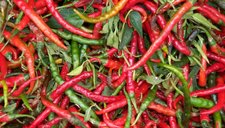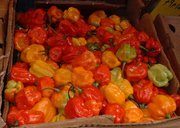Chile (capsicum)
|
|
The chile pepper (also chili or chilli; from Nahuatl chilli via Spanish chile) is the fruit of the plant Capsicum from the nightshade family (Solanaceae).
Chilis.jpg
The chile peppers and their various cultivars originate in the Americas; they are now grown around the world because they are widely used as spices or vegetables in cuisine, and even as medicine.
| Contents |
History
Cultivated since prehistoric times in Peru and Mexico, it was discovered in the Caribbean by Columbus and named a "pepper" because of its similarity in taste (though not in appearance) with the Old World peppers of the Piper genus.
Diego Alvarez Chanca, a physician on Columbus' second voyage to the West Indies in 1493, brought the first chile peppers to Spain, and first wrote about their medicinal effects in 1494.
Species and cultivars
The most common species of chile peppers are:
- Capsicum annuum, which includes many common varieties such as bell peppers, paprika, and jalape�os
- Capsicum frutescens, which includes the cayenne and tabasco peppers
- Capsicum chinense, which includes the hottest peppers such as habaneros and Scotch bonnets
- Capsicum pubescens, which includes the South American rocoto peppers
- Capsicum baccatum, which includes the chiltepin
Capsicum1.jpg
Though there are only a few commonly used species, there are many cultivars and methods of preparing chile peppers that have different common names for culinary use. Green and red bell peppers, for example, are the same cultivar of C. annuum, the green ones being immature. In the same species are the jalape�o, the chipotle (a smoked jalape�o), the poblano, ancho (which is a dried poblano), New Mexico, Anaheim, Serrano, and other cultivars. Jamaicans, Scotch bonnets, and habaneros are common varieties of C. chinense. The species C. frutescens appears as chiles de arbol, aji, pequin, tabasco, cayenne, cherry peppers, and others.
Heat
The substances that give chiles their heat are the alkaloid capsaicin (8-methyl-N-vanillyl-6-nonenamide or C18H27NO3) and four related chemicals, collectively called capsaicinoids. Each capsaicinoid has a different effect on the mouth, and variation in the proportions of these chemical is responsible for the differing sensations produced by different varieties. Capsaicin causes pain and inflammation if consumed to excess, and can even burn the skin on contact in high concentrations (habanero peppers, for example, are routinely picked with gloves). It is also the primary ingredient in pepper spray, which is used as a "less-than-lethal" weapon.
The "heat" of chile peppers is measured in Scoville units. Bell peppers rank at zero Scoville units, jalape�os at 3,000–6,000 Scoville units, and habaneros at 300,000 Scoville units. The record for the highest number of Scoville units in a pepper is assigned by the Guinness Book of Records to the Red Savina Habanero, measuring 577,000 units. However, a recent report was made of a pepper from India called the Naga Jolokia measuring at 855,000 Scoville units. Both the Red Savina and the Naga Jolokia claims are disputed as to their validity, and lack independent verification. Pure capsaicin rates at 16,000,000 Scoville units.[1] (http://www.fiery-foods.com/dave/assam_chile2.asp)
Cuisine
The fruit is eaten cooked or raw for its fiery hot flavor which is concentrated along the top of the pod. The stem end of the pod has glands which produce the capsaicin, which then flows down through the pod. Removing the seeds and inner membranes is thus effective at reducing the heat of a pod.
Well-known dishes with a strong chile flavor are Mexican salsas, Tex-Mex chili con carne, and Indian vindaloos and other curries. Chili powder is a spice made of the dried ground chiles, usually of the Mexican chile ancho variety, but with small amounts of cayenne added for heat. Bottled hot sauces such as Tabasco sauce are made from chiles such as the cayenne (not, oddly, from tabasco peppers), which may also be fermented.
Indonesian, Indian, Szechuan and Thai cuisines are particularly associated with the chile pepper, although the plant was unknown in Asia until Europeans introduced it there.
Sambal is dipping sauce made from chile with any other ingredients such as garlic, onion, shallots, salt, vinegar and sugar. It is very popular in Indonesia, Malaysia and Singapore.
Popularity
Chile peppers are popular in food, despite the pain and irritation they bring. Capsaicin has an antibacterial effect, so food cooked with chiles keeps for longer without spoiling. Chiles are rich in vitamin C and are believed to have many beneficial effects on health. The pain caused by capsaicin stimulates the brain to produce endorphins, natural opioids which act as analgesics and produce a sense of well-being. Psychologist Paul Rozin suggests that eating chiles is an example of a "constrained risk" like riding a roller coaster, in which extreme sensations like pain and fear can be enjoyed because we know they are not actually harmful.
Chillies_drying_in_Kathmandu.jpg
Birds do not have the same sensitivity to capsaicin as mammals, as capsaicin acts on a specific nerve receptor in mammals, and avian nervous systems are rather different. Chile peppers are in fact a favorite food of many birds living in the chile peppers' natural range. The flesh of the peppers provides the birds with nutritious meal rich in vitamin C. In return, the seeds of the peppers are distributed by the birds, as they drop the seeds while eating the pods or the seeds pass through the digestive tract unharmed. This relationship is theorized to have promoted the evolution of the protective capsaicin. It is interesting to note that the chemical used to give an artificial grape flavoring to food items such as grape soda does have a similar effect on birds as capsaicin has on humans.
Spelling
- Chile is the most common spelling which refers specifically to this plant and its fruit. This orthography is universal in the Spanish-speaking world, even though in some parts chile is better known as aj�.
- Chili is also quite popular, but its use is discouraged by some, as this word is more commonly used to refer to a popular Southwestern dish (chili is the official state dish of Texas[2] (http://www.tsl.state.tx.us/ref/abouttx/symbols/chili.html)), as well as to the mixture of cumin and other spices (chili powder) used to flavor it.
- The spelling chilli is used in non-American English speaking countries such as the UK and Australia. The Oxford English Dictionary lists chilli as the main spelling, and chile and chili as variant spellings.
- The name of this plant bears no relation to Chile, the country, which is named after the Quechua chin (cold), tchili (snow), or chilli (where the land ends).


